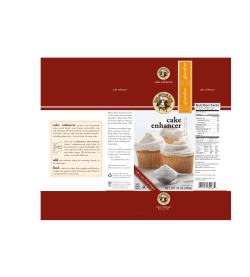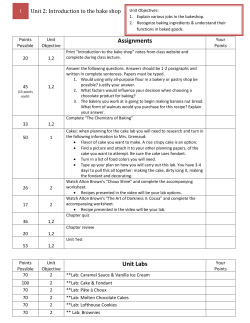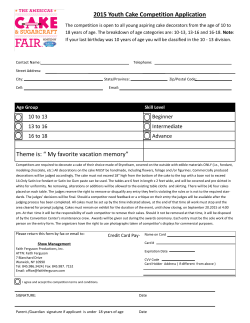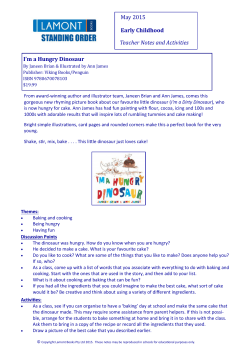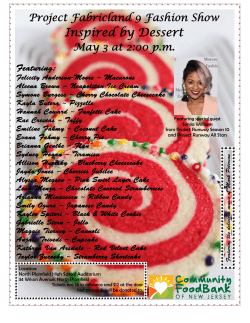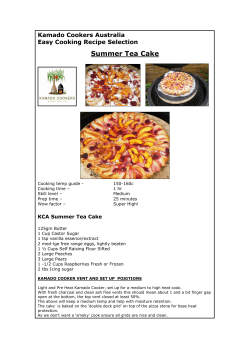
Cakes in a cup
More info about— Cakes in a cup Cakes in a cup The activity Make a simple cake batter and cook it in a microwave. ExpeRiment with different combinations of ingredients to see what effect they have. Learn how the ingredients react together to make cake. More info about— Cakes in a cup What you’ll need Special materials You can follow the recipe below or print out our recipe card on the last page, which will give you an opportunity to practice reading with your child or children. What to do Being safe There are no specific risks with this activity but we always recommend that you use common sense and take general care, for example, the cakes will be hot when they come out of the microwave, so don’t eat them immediately. •• •• •• •• •• •• •• •• A microwave Up to 6 microwaveable mugs Plain flour Baking powder Up to 6 small or medium eggs Vegetable oil Water Measuring spoons (or some other way to measure out tablespoons of flour, sugar, oil and water and ¼ tablespoon of baking powder). •• Fork to stir with Get your child/children to read the following recipe and put the ingredients into a mug. •• 4 tablespoons plain flour •• 2 tablespoons caster sugar •• ¼ teaspoon baking powder •• 1 small/medium egg •• 2 tablespoons vegetable oil •• 2 tablespoons water Stir the ingredients together thoroughly using a fork. Make sure there are no dry bits of flour left at the bottom of the mug. Ask your children questions about what the batter looks, feels and even tastes like (though of course the batter does contain raw eggs, so don’t eat too much of it). Cook the mixture in the microwave on full power for 2 minutes. Take the cake out of the microwave and allow it to cool for a minute or so. You can eat the cake straight out of the mug, but if you want to examine it closely, you can take it out of the mug and put it onto a plate. Continues >> More info about— Cakes in a cup What to do (continued) Introduce the idea that different ingredients do different things for the cake and try to get your child/children to suggest experimenting to see what happens when you remove one ingredient at a time. See what happens when you make cakes, leaving out one ingredient at a time. For example, leave out the egg, leave out the oil, leave out the baking powder. Examine the resulting cakes by looking closely at them, feeling and tasting them. All the cakes should be edible, although some might be tastier than others. Questions to ask children Why do you think we need all these ingredients? Why do you think we need to mix them all together? After making cake mixture: What do we need to do to turn this into a cake? What do you think will happen if we don’t include the egg? How could we find out? What do you think will happen if we don’t include the oil? What do you think will happen if we don’t include the baking powder? After ‘proper’ cake is cooked: What does this cake look like? What does this cake feel like? How does the cake taste? After cakes with missing ingredients are cooked: What does this cake look like? What does this cake feel like? How does the cake taste? How is it different to the cake with all the ingredients? What do you think the egg/oil/baking powder does in the cake mixture? More info about— Cakes in a cup The science Mixing the ingredients together helps all the ingredients to come into contact with other and gets them ready to react with each other. The microwave provides the energy needed for the chemical reactions to take place and turn the mixture into cake. Removing the baking powder produces a flat cake which isn’t very spongy. That’s because baking powder contains chemicals which react to produce carbon dioxide gas which gets trapped in little pockets in the cake when it cooks. Removing the egg produces a cake that doesn’t have much structure. That’s because eggs contain long chain-like molecules (called proteins) which unravel and form new hard, strong structures inside the cake when cooked, as you’ll know if you’ve fried or boiled an egg. Removing the oil from the recipe produces a very dry cake because without the oil to coat the other ingredients, the cake mixture dries out when heated. Going further See what happens if you remove ingredients and replace them with something else. For example, what happens if you replace the water with milk, or one tablespoon of the flour with cocoa powder. Try adding other ingredients to the mix – raisins, chocolate chips, mashed banana. See if you can come up with your own perfect cake in a cup recipe. Read about how scientists have learnt to ‘uncook’ eggs: http://bit.ly/UnBoilEgg Microwave mug cake Recipe card Ingredients: 4 tablespoons plain flour 2 tablespoons caster sugar ¼ teaspoon baking powder 1 small/medium egg 2 tablespoons vegetable oil 2 tablespoons water Method: 1. Mix all the dry ingredients together in a mug 2. Then break the egg into the mug and add the oil and water 3. Stir vigorously with a fork 4.Zap the resulting mixture in your microwave at full power for 2 minutes rigb.org/experimental
© Copyright 2025
